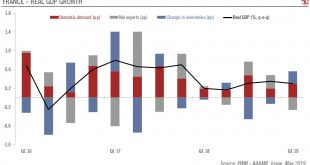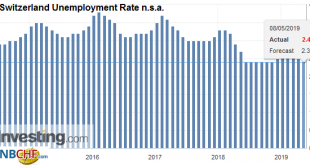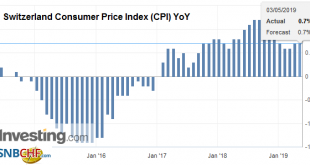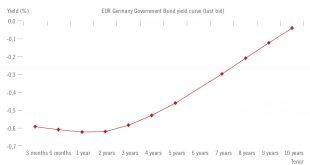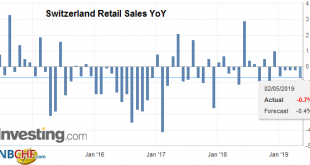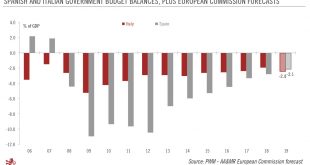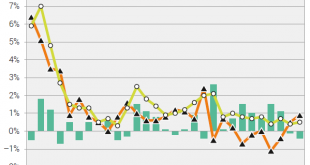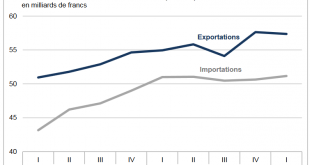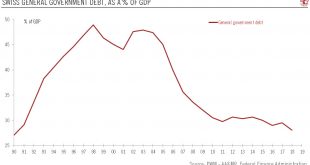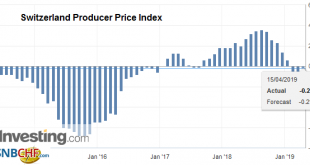The French government’s respond to the ‘yellow vest’ protests could provide a meaningful boost to consumer spending, mostly next year. Following a series of townhall meetings with French citizens up and down France, President Emmanuel Macron responded to social unrest with two doses of fiscal easing. The December package (worth EUR10bn) was incorporated in the stability plan sent to Brussels before Easter and is...
Read More »Switzerland Unemployment in April 2019: Unchanged at 2.4percent, seasonally adjusted unchanged at 2.4percent
Unemployment Rate (not seasonally adjusted) Registered Unemployment in April 2019 – According to surveys by the State Secretariat for Economic Affairs (SECO), at the end of April 2019, 107,298 unemployed persons were registered at the regional employment agencies (RAV), 5,043 fewer than in the previous month. The unemployment rate fell from 2.5% in March 2019 to 2.4% in the month under review. Compared to the same...
Read More »Swiss Consumer Price Index in April 2019: +0.7 percent YoY, +0.2 percent MoM
03.05.2019 – The consumer price index (CPI) increased by 0.2% in April 2019 compared with the previous month, reaching 102.4 points (December 2015 = 100). Inflation was 0.7% compared with the same month of the previous year. These are the results of the Federal Statistical Office (FSO). The 0.2% increase compared with the previous month can be explained by several factors including rising prices for fuel and for air...
Read More »Is Europe turning Japanese?
European investment opportunities remain, despite financial repression in the region. The European Central Bank (ECB) surprised market watchers with its dovish turn in January, wiping out any prospect of an interest-rate rise this year and revising its growth projections for the euro area downward for 2019. With Europeans set to live with interest rates at zero (or negative) for longer, many are wondering if Europe now...
Read More »Swiss Retail Sales, March 2019: -0.5 percent Nominal and -0.2 percent Real
02.05.2019 – Turnover in the retail sector fell by 0.5% in nominal terms in March 2019 compared with the previous year. Seasonally adjusted, nominal turnover fell by 0.1% compared with the previous month. These are provisional findings from the Federal Statistical Office (FSO). Real turnover in the retail sector also adjusted for sales days and holidays fell by 0.7% in March 2019 compared with the previous year. Real...
Read More »Peripheral bonds after the Spanish election
We remain underweight peripheral euro area bonds in general due to continued political uncertainty, which will feed volatility. On April 28, Spain held its third general election in less than four years. As was expected, the centre-left Socialists (PSOE) emerged the largest party, but it does not have an absolute majority, so negotiations with other parties will be needed. But the political fog in Spain is unlikely to...
Read More »Swiss wage index 2018: Nominal wage increase of 0.5 percent in 2018, real wages decrease by -0.4 percent
30.04.2019 – The Swiss nominal wage index rose by +0.5% on average in 2018 compared with 2017. It settled at 101.6 points (base 2015 = 100). Given an average annual inflation rate of +0.9%, real wages registered a decrease of -0.4% (100.5 points, base 2015 = 100) according to calculations by the Federal Statistical Office (FSO). Development of nominal wages to the consumer prices and real wages 1990-2018 Source:...
Read More »Swiss Trade Balance Q1 2019: Foreign trade at a high level
We do not like Purchasing Power or Real Effective Exchange Rate (REER) as measurement for currencies. For us, the trade balance decides if a currency is overvalued. Only the trade balance can express productivity gains, while the REER assumes constant productivity in comparison to trade partners. Who has read Michael Pettis, knows that a rising trade surplus may also be caused by a higher savings rate while the trade...
Read More »Swiss Policy Mix Review
Despite a record of federal budget surpluses, don’t count on fiscal policy to relieve pressure on the SNB The Swiss federal budget is governed by a strict expenditure rule, which is enshrined in the Constitution. Since its introduction, the ratio of public debt-to-GDP has been significantly reduced, falling back to its early-90’s level. At the close of 2018, the Swiss federal budget registered a significant surplus of...
Read More »Swiss Producer and Import Price Index in March 2019: -0.2 percent YoY, +0.3 percent MoM
The Producer Price Index (PPI) or officially named “Producer and Import Price Index” describes the changes in prices for producers and importers. For us it is interesting because it is used in the formula for the Real Effective Exchange Rate. When producers and importers profit on lower price changes when compared to other countries, then the Swiss Franc reduces its overvaluation. The Swiss PPI values of -6% in 2015...
Read More » Swiss Economicblogs.org
Swiss Economicblogs.org

